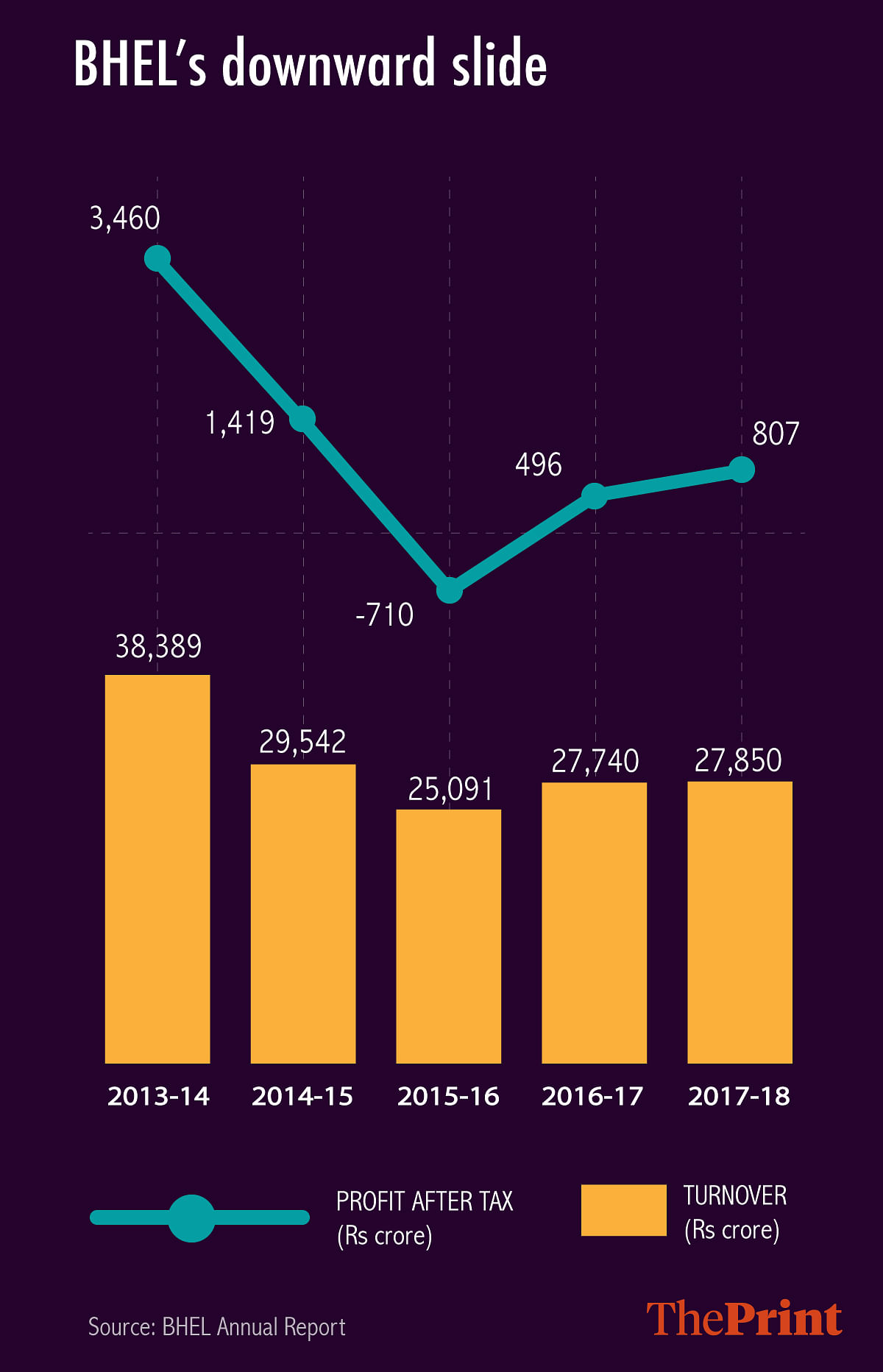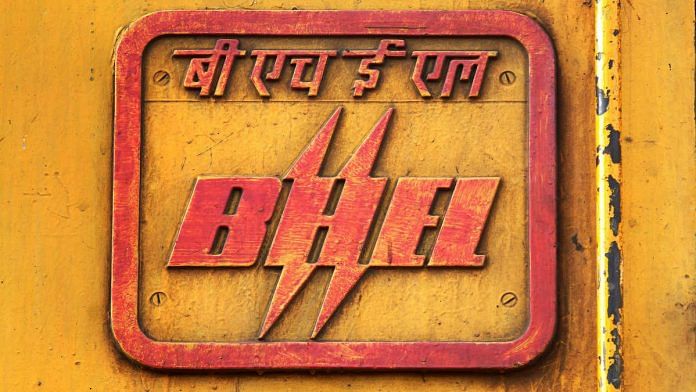New Delhi: Bharat Heavy Electricals Ltd (BHEL), the state-owned blue-chip power generation equipment manufacturer, is hoping to leapfrog into the future with a lithium ion battery plant.
But before it can move forward, the public sector behemoth will have to shake-off its disastrous recent past.
BHEL, which heralded the era of indigenous heavy equipment manufacturing in the country almost 55 years back, is today a stark example of yet another public sector giant whose heydays are history.
In the last four years alone, its turnover has fallen 27 per cent — to Rs 27,850 crore in 2017-18 from Rs 38,389 crore in 2013-14.
Its net profit too has seen a sharp 77 per cent drop during this period — to Rs 807 crore in 2017-18 from Rs 3,460 in 2013-14.

In between, it even registered a loss of Rs 710 crore in FY16, just a year after it posted a profit Rs 1,419 crore.
This decline is also reflected in the performance of the BHEL share in the stock markets.
The company’s market capitalisation, a key indicator to assess its value, has shrunk significantly — from Rs 49,062.14 crore on 30 September 2014 to less than half at Rs 22,198 crore as of 5 March 2019, or a 55 per cent fall.
Three BHEL officials, including one still with the PSU, told ThePrint on condition of anonymity that faulty diversification, expanded workforce, altered requirements of market forces and the very public sector characteristic of the company have impacted its efficiency and bottom line.
A report by the Comptroller General of India (CAG) in 2017 had pointed out that it was imperative for BHEL to enhance its competitiveness through cost reduction to maintain the growth momentum.
ThePrint reached BHEL chairman and managing director Atul Sobti and the firm’s spokesperson for comment but there was no response until the time of publishing this report. It will be updated when they respond.
Also read: Market cap of public sector firms has slumped under Modi govt but private have prospered
Lack of diversification
In its report, the CAG had said adequate and effective diversification into areas which were profitable was not done by the company and this led to a sharp decline in its turnover and profitability.
It also highlighted that while the company was quick in identifying the problem areas and the changes required, it failed in their resolution.
For the period 2012-17, BHEL put in place ‘strategic plan’ targets with focus on diversification and innovation to cope with the changing times and the resultant challenges. However, it was poorly implemented.
Mismanagement of manpower
“Rationalisation of manpower according to level of operation was essential to maintain margin, competitiveness and business growth as manpower cost constituted significant component of the Company’s expenses,” the CAG report had said.
It noted that despite slowdown in power sector since 2010-11 and dampening investment sentiments, BHEL inducted 9,346 employees in the calendar year 2011 and 2012 as against retirement of 5,844 employees during this period.
As a result, the percentage of employee cost to turnover increased consistently from 11.04 per cent in 2011-12 to 20.84 per cent in 2015-16.
A senior BHEL official who retired recently said, “For BHEL, market forces and requirements changed but it failed in diversifying appropriately and in a timely manner.”
The company has also suffered for being in the PSU framework, said the former official on condition of anonymity.
“There have been problems in efficient decision-making required to make quick changes. When you are a PSU, you are bound by so many parameters that often are detrimental,” added the former official.
BHEL’s annual report of 2017-18 said that after witnessing a declining performance trend up to 2015-16, the company “gave utmost priority to expeditious execution of orders coupled with strict cost control, efficient utilisation of resources through consolidation, and enhancing speed of response through simplification”.
However, Pranav Haldea, managing director, Prime Database, said, “The problem is not just with BHEL but most PSUs. The decision making process is slow and most of them lack the required governance standards, red tape-ism still exists.
“Besides, now they have to face intense competition with more and more companies coming to India and trade between countries going up,” added Haldea.
Also read: Going back in time – PSUs continue to call the shots in the defence ministry




I believe we should all be unanimous on one point. Govt is worst at doing business and best at regulating.
Irrespective of the regime, no govt organisation can beat private initiative. Sooner or later we have to allow our pvt sectors to grow. Defence sector has just been opened to pvt investment and let us allow them time, they will soon become as
competitive as auto sector…which if you remember..30 yrs ago could not produce more than 3/4 models only.
As for the author, I can ask him..he himself is part of a pvt initiative…does he believes the stories belted out by DD news????
The article appears to have an intention to discredit the current government. The one-sided view pops out many inconsistencies, some of which are:
1) From the graph it is clear that the company has seen a reversal of its fortunes in the last three years, but the article cherrypicks only the initial dip.
2) Notably, the CAG report is for the period up to FY15-16. The growth in revenues & profitability, and the accelerated diversification are undisputed for the period afterwards.
3) The increase of manpower also took place in the period period before FY15-16. Afterwards, the manpower has decreed from 40,000 to 35,000 presently (a decrease of 12%), while the productivity (revenue per employee) has increased by about 20%.
4) Moreover, the article needlessly pitching an antiestablishmentarian undertone, fails to acknowledge the current state of affairs at the company. Under an able leadership, besides securing a100% market share in the conventional thermal sector, the company is taking unprecedented steps towards new growth areas like:
a) developing super efficient, low on pollution, world’s first advanced ultra supercritical technology for coal power plants;
b) indigenously developing propulsion technology for railways, (have developed regenerative diesel loco, is supplying air conditioned EMUs, and have record haul of orders in the transportation sector);
c) venturing into e-mobility and battery manufacturing;
d) getting into rail track electrification, and developing the vacant land besides the track to generate solar power and feed electricity to the grid.
e) consolidating the presence in solar sector (getting record number of orders, established trackers and floating types also); and
f) expanding offering in nuclear power sector, etc.
By failing to take into account, both sides of the story, the seemingly biased write up may not appeal much to the rational minds, and thus will not succeed in tarnishing the image of the current establishment.
Very surprising to see the journalist compare figures of 2013-14 to 2017-18 just to prove a point. Even more surprising is that the journalist conveniently omits the fact that there is a clear uptick in the company’s performance post 2016, which is ironically clearly visible in the graphical representation in the story itself.
This appears to be a patchwork story aimed at targeting the current regime. The journalist conveniently cherry-picks points to suit the slant of the story from a spectrum ranging from 2010-11 to 2017-18 . The CAG report, cited in the story also refers to FY 2015-16 and the comments picked are generic in nature and not damning or castigating at all. How can this be linked to the current dispensation is befuddling. It’s as if the NDA govt. has been shoehorned into the story.
“Statistics are like mini skirts, they hide more than what they show”
The author has taken 2013-14 as their base year, had they taken 2011-12 for the same, it would have have come out that the turnover in 2011-12 was 49100 crores with a profit of more than 6000 crores. The same reduced to 38369 crores and 3800 crores by 2013-14. The turnover of BHEL has stabilized at around 28000 crores. A major reason for the slide was the coal scam due to which many power projects got stalled and after that very few private sector companies have ventured in power manufacturing business. Also in the past 2 years or so, BHEL has got 100 % of the orders that have come up for bidding in the domestic market. The going has been tough but BHEL has been recovering.
PS: I work in BHEL .
What has Swadeshi got to do with PSUs. If the Private Sector rises to the standard so be it. The movement away from Thermal Power Generation is fall out of the Climate Change management. To be in step with the market, every company whether in the private or public sector will have to be in tune. BHEL will change track and bounce back. As will any healthy industrial concern. What has Modi got to do with it?
The article says:
“It noted that despite slowdown in power sector since 2010-11 and dampening investment sentiments, BHEL inducted 9,346 employees in the calendar year 2011 and 2012 as against retirement of 5,844 employees during this period.”
Such redundant recruitment done under UPA….yet author finds fault with Modi!!
It’s high time to kill PSUs
These are the mistakes made by Congress to pump oxigen at the cost of common man to keep Nehru’s name.
According to press reports the contract between Dassault and Anil Ambani’s company is merely 800 crores and is not for manufacturing any part of Raffle aircraft. How is HAL got ignored? Can some body enlighten me?
Country is not now expected to produce 80+ planes, which HAL was to do. Does this help please?
The problem is government is helping Private sector at the cost of PSU or else why HAL was over shadowed by AA who has no experience of Making fighter jet. All these political parties get donations in return of giving them government orders. Even now unless money gets to party or some one no can dream of government orders. No wonder some one or other from business are also in the business of politics. Modi is not an angel.
Latest is that BSNL staff has not been paid salaries for Feb. TIFR staff was told to take half the salary. Is this New India or is the government itself bankrupt? Or is it that we have to meet the fiscal deficit target as specified by the international rating agencies, ably guided by the IMFs of this world, even if they have to be met at the cost of ordinary Indians? Another one that I have come to know is that other institutes of higher learning are also being denied the required funding and they are cutting honorarium for visiting faculty.
Swadeshi is only a chunavi jumla! A large number of the government policy choices are meant to improve EODB for MNCs and large Indian corporates. PSUs and Small Businesses are only a pawn in that game. Remember the traders body is fighting new e-commerce policy and the start-ups are figuring out whether they are liable to taxes or not.
The article finds the fault of the bureaucracy by not implementing the recommendations of CAG…… Who do you think the Govt is….. The Govt is not made up of politicians but by the Govt Babu’s…… If Govt babus won’t work according to their oath to the constitution, then no Modi can do wonders for the country….. In that way your title of the article is deceptive….. Even though in a PSU structure, autonomy is granted to the institutions….. If Modi government interfere in their decision making even then ThePrint have a problem with that…… Fourth estate has also failed this great country by either not realising it’s reporting or habitual Modi hater …….